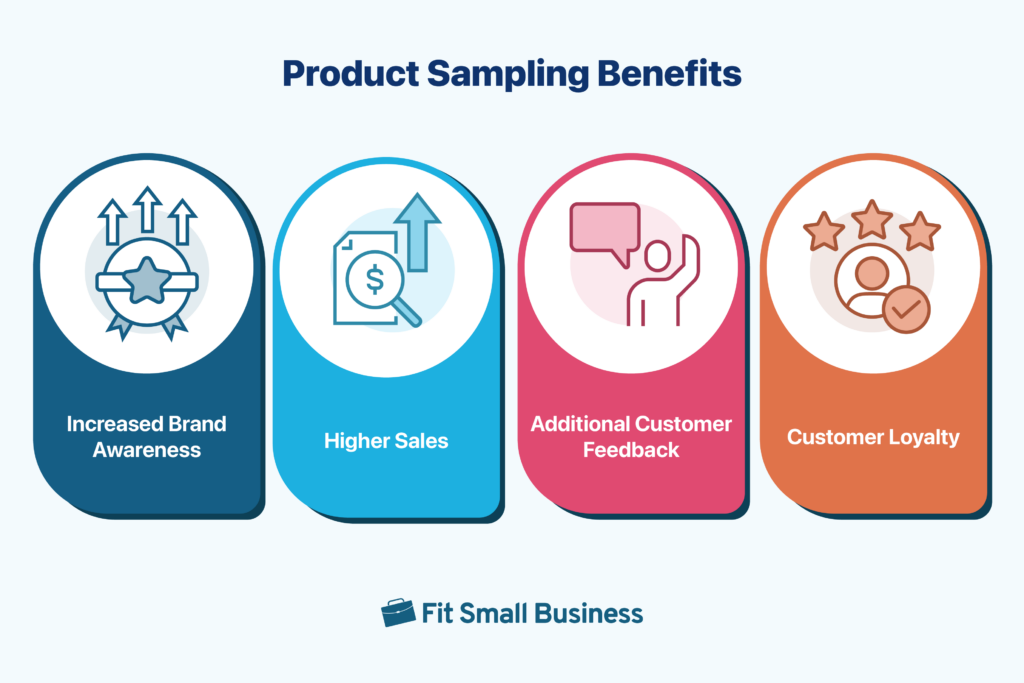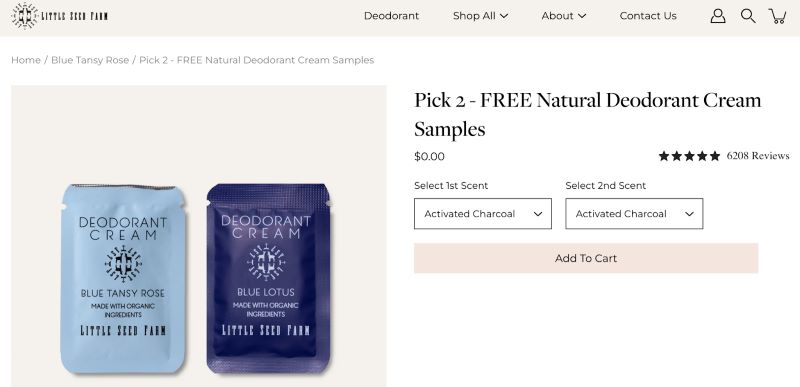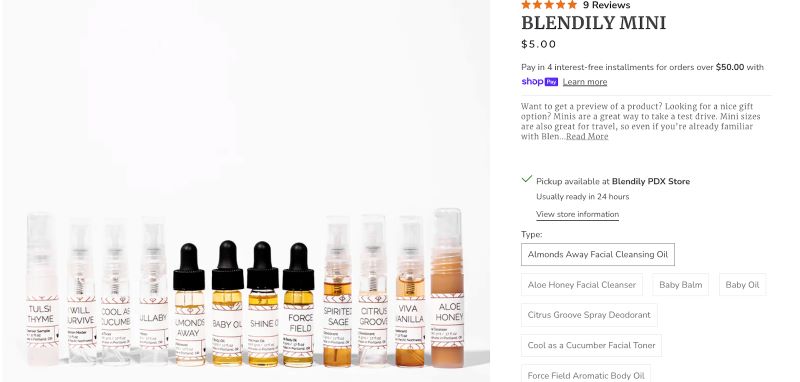Product sampling introduces a business’ products to potential customers, and it can be a powerful tool to generate interest in products, build brand awareness, and drive sales. New retail businesses or established brands can use product sampling to market their products.
In this article, learn about product sampling—what it is, its benefits, various strategies, and examples of successful implementation.
What Is Product Sampling?
Product sampling is a retail marketing strategy where businesses offer free samples of their products to potential customers. Consumers get a chance to try the product before making a purchase, increasing the likelihood they’ll buy it.
Product sampling is especially effective for food and beverage products, cosmetics, skincare, and other items where the sensory experience is crucial to the buying decision.
When to Use Product Sampling
Small retail businesses should consider using product sampling to achieve specific marketing objectives or address particular business needs. Here are some scenarios where product sampling can be particularly effective:
Launching a New Product
If you’re introducing a new product to the market, product sampling can be a great promotion tactic. It can help generate buzz around your products and encourage trial among potential customers.
Selling Products That Need Education
Not every product is straightforward, and sometimes people need to see something or try something for themselves before they’re convinced. For products that require explanation or demonstration to showcase their features or benefits, product sampling can help educate customers and overcome any skepticism or uncertainty they may have.
Competing With Established Brands
If you’re competing with larger, more established brands in your market, product sampling can help level the playing field. This gives customers a chance to compare your products directly with those of your competitors.
Seasonal Promotions
Holidays, special events, or peak seasons are great times to offer samples. Product sampling can be part of promotional campaigns to drive foot traffic to your store, boost sales, and capitalize on increased consumer spending.
Clearing Excess Inventory
If you have excess inventory or slow-moving products, get rid of them with samples. Offering samples can help reduce inventory levels by giving customers a taste of the product and incentivizing them to make a purchase.
Benefits of Product Sampling

Product sampling offers lots of benefits for retailers, including:
Build Brand Awareness
If your brand is relatively new or not well-known, product sampling can help increase brand visibility and introduce your products to a wider audience. If you’re looking to expand into new geographic markets or target new customer segments, product sampling can help introduce your products to these audiences and gauge their receptiveness.
Increase Sales
Tap into what’s known as the “reciprocity effect.” Essentially, when people feel like they’re receiving something for free, they’re more likely to want to return the favor and show support—in retail, this usually means making a purchase.
Product sampling can be an effective tactic to drive sales, especially for products with a high perceived value or those that require customers to experience them firsthand to appreciate their benefits.
Collect Customer Feedback
Product sampling provides an opportunity to get feedback from customers about your products. Ask about their likes, dislikes, and suggestions for improvement. This information is extremely valuable for things like product development and marketing.
Foster Customer Loyalty
Product sampling can be used as a way to reward loyal customers or incentivize repeat purchases by offering them exclusive samples or sneak peeks of new products. For instance, nearly three-quarters of consumers favor cosmetics brands that send free samples compared to those that don’t.
Product Sampling Strategies & Examples
There are many different types of product samples. Sampling can take place in various locations such as retail stores, farmers markets, trade shows, or even through online platforms.
In-store Sampling
In-store sampling is when you offer samples of your products directly in a retail store, either your own or a store where you sell your products. This allows customers to experience the product while they shop, increasing the likelihood of a purchase.
An Instagram post advertising Blendily’s “Mask & Sip” event
Skincare brand Blendily has storefronts in Seattle and Portland. It offers a complete sample experience with its “Mask & Sip” event. Shoppers can enjoy a face mask, sampling the product in-store, while sharing time and a beverage with their friends in the Blendily space.
You might also consider hosting live product demos in your store to showcase the features and benefits of your products. This interactive approach can help customers understand how your products work and why they should buy them.
Event Sampling
Event sampling is when you attend local events, festivals, or trade shows to distribute samples of your products. This strategy can help you reach a large number of new potential customers in a short amount of time. It also allows you to target the people you reach with your samples, as they’re gathering over a common interest in a specific event.
Street Sampling
You can also set up a booth or stand in high-traffic areas such as city centers, shopping districts, or busy sidewalks to distribute samples to passersby.
In New Orleans, for example, lots of retail salespeople stand outside the storefronts to offer samples and lure foot traffic into the stores. You’ll see this commonly with skincare shops, with associates offering free samples of soap to pedestrians before inviting them into the store.
Partnership Sampling
Partner with complementary businesses to offer samples of each other’s products. This can help you reach new audiences and expand your customer base. It also takes some of the pressure of planning and promotion off your shoulders, as you can share the work and cost with another brand. A coffee shop could offer samples of a local bakery’s pastries, while the bakery offers samples of the coffee shop’s beverages.
Synth Sound Baths, for example, hosts monthly sound healing events, when it offers samples of Fermento Comio kombucha, a local business it collaborates with. Event attendees can also purchase bottles of the kombucha on the spot.
Synth Sound Baths advertising a Spring Equinox Sound Bath
Online Sampling
You don’t need to connect with people in person to give product samples. Offer samples of your products through your website or social media channels. This strategy can help you engage with customers who prefer to shop online and reach a wider audience beyond your local area.
Little Seed Farm, for example, offers free samples of two of its natural deodorant products to online shoppers.

Little Seed Farm’s sample selection product page
You can also charge a small fee for samples, like Blendily does with its mini-sized skincare products:

Blendily offers low-cost mini sizes of its products for customers to sample before investing in a full-size product.
Warby Parker also has a well-known and -liked Home Try-On program. Customers can try the glasses on at home for a bit before committing to the purchase.
Sampling Kits or Boxes
Create sampling kits that include multiple samples of your products along with promotional materials or coupons. Distribute these kits at events, in-store promotions, or through mail or email campaigns.
You could also partner with subscription box services to include samples of your products in their monthly boxes. This can expose your products to a targeted audience of consumers interested in your product category.
Or, create your own sample subscription boxes. If you have enough products or brand collaborators, you can build a subscription offering of your own with product samples. This curation approach is similar to what IPSY and Scentbird do.
Free With Purchase
You can offer samples as a way to incentivize shoppers to make a purchase. Offer a sample in exchange for a qualifying purchase. For example, you might offer more or higher-value samples for purchases that meet a certain spend threshold. Or you might offer a sample if a customer purchases a specific promotional product.
Sephora, for example, offers two free samples with every purchase. This encourages repeat purchases so customers can get new samples each time.
Tips for Product Sampling
Before you offer product samples, keep the following tips and best practices in mind:
Know Your Audience
It’s essential to target the right audience and choose the appropriate sampling locations to maximize the impact. Understand your target customers’ preferences, needs, and shopping habits to ensure that your sampling efforts are effectively reaching and resonating with them.
Choose the Right Products
Select products for sampling that are popular, high-quality, and representative of your brand. Focus on items with a high likelihood of converting samplers into paying customers.
Provide a variety of samples to cater to different tastes and preferences. Consider offering samples of complementary products or product variations to encourage upselling.
Ensure Proper Presentation
Pay attention to the presentation of your samples, including packaging, labeling, and serving/display methods. Make sure they are visually appealing and reflect the quality of your brand.
Train Sampling Staff
If you have staff assisting with sampling, ensure they are knowledgeable about the products, friendly, and engaging with customers. Provide training on product features, benefits, and how to handle customer inquiries.
Capture Attention
Choose the right timing and locations for sampling activities to maximize exposure and foot traffic. Consider peak shopping times, high-traffic areas, and events where your target audience is likely to be present.
Use eye-catching signage, displays, or demonstrations to attract customers to your sampling station. Incorporate branding elements and messaging that clearly communicate the value proposition of your products.
Engage With Customers
Encourage interaction and conversation with customers during sampling activities. Ask for feedback, answer questions, and use the opportunity to educate them about your products and brand.
Offer incentives such as discounts or exclusive offers in exchange for customer contact information (e.g., email addresses) to build your marketing database and nurture ongoing relationships.
After sampling activities, follow up with customers who expressed interest or provided contact information. Send thank-you emails, special offers, or invitations to visit your store again to encourage repeat business.
Measure Results
Track key performance metrics such as foot traffic, sample distribution, customer interactions, and sales conversion rates to evaluate the effectiveness of your sampling efforts and inform future strategies.
Comply With Health & Safety Regulations
Ensure compliance with health and safety regulations when handling and serving food or beverage samples. Maintain cleanliness, proper food handling practices, and adhere to local health department guidelines.
Frequently Asked Questions (FAQs)
Here are some of the most common questions we encounter about product sampling.
To sample your product, start by defining your goals. Then, choose the product, what kind of sample you’re going to offer, and how you’re going to offer it. Then, promote the product sampling program, collect feedback, and track the results.
There are many purposes for a product sample. You might collect customer feedback, promote brand awareness, drive sales of a new product, or build customer loyalty, among other things.
Product sampling is good because it can boost sales, awareness, loyalty, and the bottom line. It gives customers a chance to try your products so they’ll hopefully want to buy them as a result.
Bottom Line
Product sampling is a versatile and effective marketing strategy with benefits for both retailers and shoppers alike. From increasing brand awareness and driving sales to collecting valuable customer feedback and fostering loyalty, there’s a lot of potential behind product sampling. By implementing strategic sampling initiatives and following best practices, you can engage with customers, differentiate your brand, and boost your bottom line.